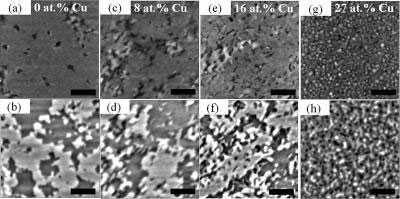| May 20, 2013 |
Iron-platinum alloys could be new-generation hard drives
|
|
(Nanowerk News) Meeting the demand for more data storage in smaller volumes means using materials made up of ever-smaller magnets, or nanomagnets. One promising material for a potential new generation of recording media is an alloy of iron and platinum with an ordered crystal structure. Researchers led by Professor Kai Liu and graduate student Dustin Gilbert at the University of California, Davis, have now found a convenient way to make these alloys and tailor their properties ("Tuning magnetic anisotropy in (001) oriented L10 (Fe1-xCux)55Pt45 films ").
|
 |
| These atomic force microscope images show how adding copper to an alloy of iron and platinum changes the crystal structure and magnetic properties, important for data storage. (Image: Kai Liu, UC Davis)
|
|
"The relatively convenient synthesis conditions, along with the tunable magnetic properties, make these materials highly desirable for future magnetic recording technologies," said Liu, a professor of physics. The iron-platinum alloy has the ability to retain information even at extremely small nanomagnet sizes, and it is resistant to heat effects.
|
|
Previous methods for making the iron-platinum alloys with an ordered crystal structure involved high-temperature treatments that would be difficult to integrate into the rest of the manufacturing process, Liu said.
|
|
The researchers, including Liang-Wei Wang and Chih-Huang Lai of the National Tsing Hua University, Taiwan, and Timothy Klemmer and Jan-Ulrich Thiele, of Seagate Technologies in Fremont, used a method called atomic-scale multilayer sputtering to create a material with extremely thin layers of metal, and rapid thermal annealing to convert it into the desirable ordered alloy. They were able to adjust the magnetic properties of the alloy by adding small amounts of copper into particular regions of the alloy.
|

